Contemporaries in the Holy Roman Empire
|
Wittelsbach Dukes in Bavaria
Albert IV 1447-1508, reigned 1465-1508 William IV 1493-1550, reigned 1508/11-1550 Louis X 1495-1545, reigned in Landshut 1514-45 Albert V 1528-79, reigned 1550-79 |
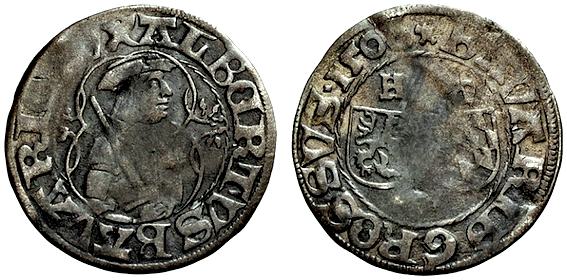
Weißgroschen 1506, Munich. Ø 22 mm, 2,19 g. Hahn 8b; Witt. 197. Obv.: ALBᗺRTVS BAVARIᗺ DVX (ᗺ = gothic E) Bust to the right, with hat and shouldered sword in a fine edging. Rev.: ¤BAVARIᗺ (ᗺ retrograde) GROSSVS·I506 H - A (= Herzog Albert) over associated shields lion / rhombic, below loop.
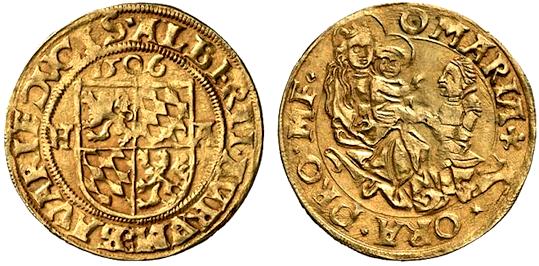
Gulden 1506, Munich. Ø 22 mm, 3,28 g. Hahn 9; Witt.188c; Friedb.178. Obv.: ·ALBERTI·AVRVM·BAVARIE DVCIS Quartered coat of arms Palatinate/Bavaria (lion/rhombic) between H - A (Herzog Albrecht), on top 1506. Rev.: O MARIA¤ - ·ORA·PRO·ME· "O Mary, pray for me" Kneeling duke in front of Maria sitting with child.
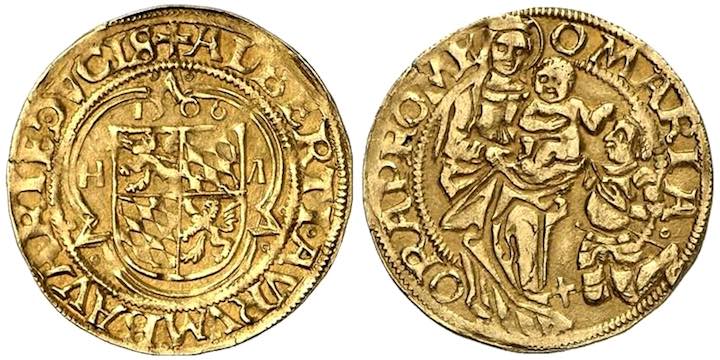
Gulden 1506, Munich. Ø 22 mm, 3,25 g. Hahn 11; Friedb.177. Obv.: +ALBERTI·AVRVM·BAVARIE DVCIS In trefoil: coat of arms between H - A, on top the date 1506. Rev.: O MARIA. - ORA PRO·ME - Kneeling duke in front of standing Maria with child.
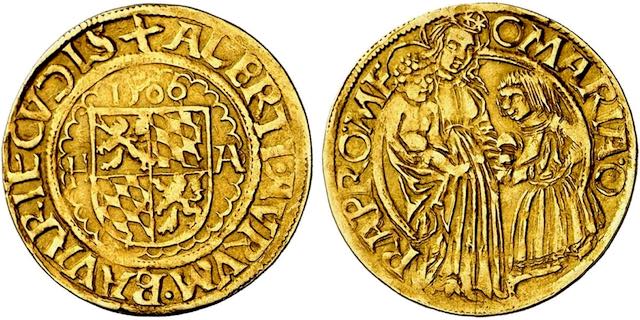
Gulden 1506, Munich. Ø 22 mm, 3,23 g. Hahn 11; Friedb.177a. Variant with the child on the right arm of Maria. DVCIS with typing error.
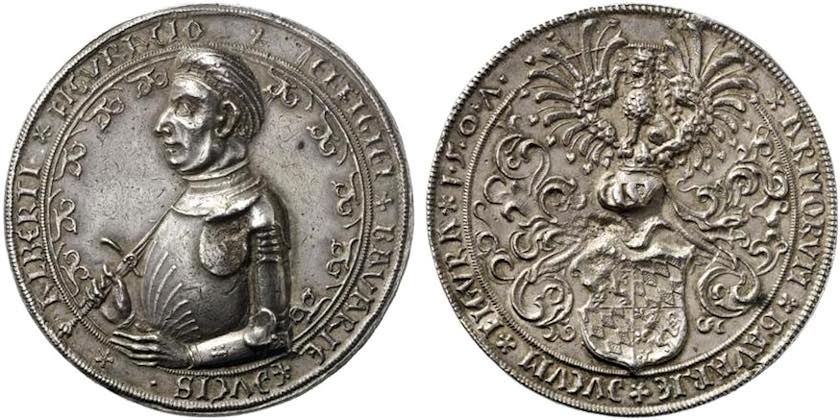
Schauguldiner 1507, dies from Benedikt Burkhart (Hall, Tirol). Ø 46 mm, 29,81 g. Domanig 5 (Erzhaus) & 32 (Dt. Medaille); Witt.217; Moser-Tursky 87. According Domanig the oldest German embossed medal. Obv.: ALBERTI ¤ FIGVRACIO ¤ IEFFIGIEI ¤ BAVARIE ¤ DVCIS "figure of the effigy of the Duke Albert of Bavaria" Effigy to the left, in armor with a wire hood and shouldered sword. Rev.: ¤ ARMORVM ¤ BAVARIE ¤ DVCVM ¤ FIGVRA ¤ 1·5 0·Λ· (Λ = 7, not 4) "figure of the bavarian dukes coat of arms" Quartered coat of arms Palatinate/Bavaria (lion/lozenge) with helmet and crest.
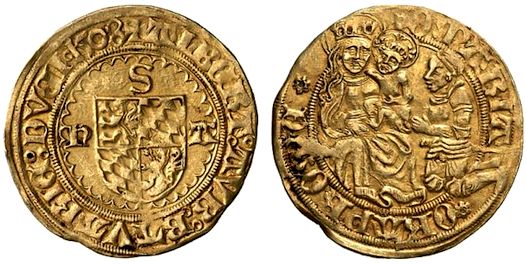
Gulden 1508, Straubing. Ø 22 mm, 3,25 g. Hahn 17; Witt.223b; Friedb.179. Obv.: ✠ALBERT⦂AVRum⦂;BAVARIE⦂DVCI◦I508 - coat of arms between h - A, above S. Rev.: O:MARIA - ¤ORA·PRO·ME¤ - kneeling duke in front of Maria sitting with child. A mint in Straubing (mintmark S) produced Gulden, Halbbatzen, Pfennige and Heller in 1506-1511. |
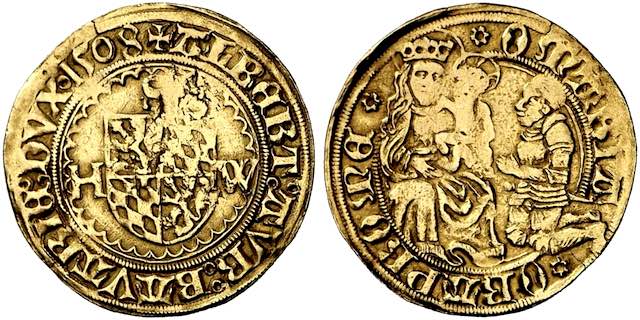
Gulden 1508, Straubing. Ø 22 mm, 3,26 g. Hahn 17; Friedb.179. Obv.: ✠ALBᗺRT⦂AVRum⦂BAVARIᗺ⦂DVX◦I508 arms between H - W (Herzog Wilhelm), on top S (Straubing). Rev.: ¤O ᙏARIA - ¤ORA·PRO·ᙏE¤ - kneeling duke in front of Maria sitting with child on her left arm. The mint in Straubinger was closed already in 1511 because the operation was apparently not profitable.
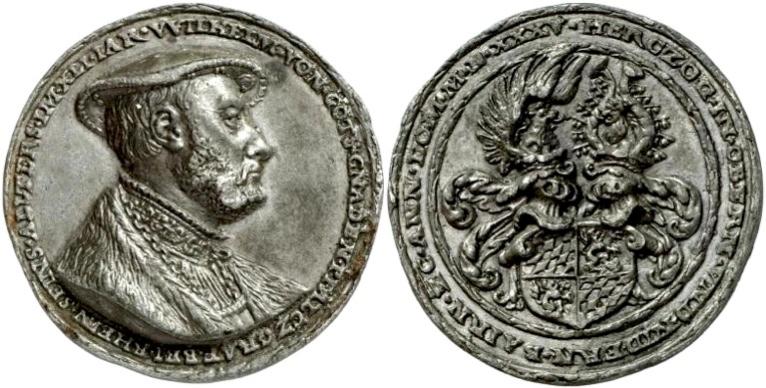
Cast lead medal 1535, model by Matthes Gebel. Ø 42,5 mm. Habich 1122; Witt.255. Obv.: VVILHELM·VON·GOTS·GNADEN·PFALCZ GRAF·BEI·RHEIN·SEINS·ALLTERS·IM·XLI·IAR· "William by the grace of God Palatine at the Rhine in his 41st year of age" Bearded bust with hat, coat and necklace to the right. Rev.: HERGZOG·IN·OBERN·VND·NIDERN·BAIRN·ZC·ANN·DOM·M·D·XXXV· "Duke of Upper and Lower Bavaria etc, anno domini 1535" Quartered coat of arms Bavaria/Palatinate (rhombic/lion), double helmeted. William's wife Jakobaea Maria of Baden, granddaughter of Christoph I. 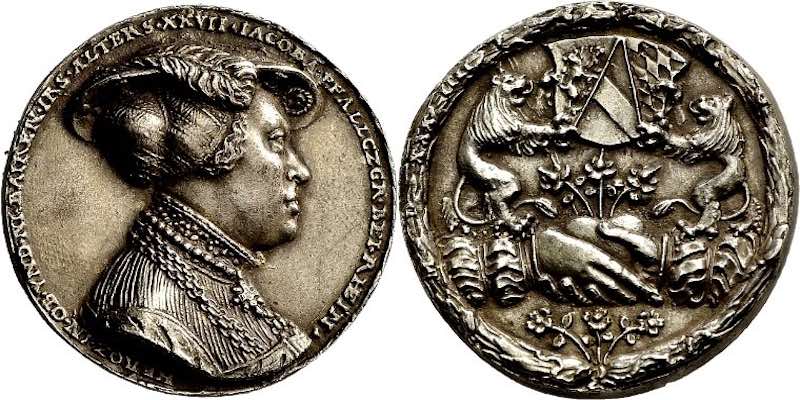
Cast medal 1534, model by Matthes Gebel. Ø 39 mm, 37,73 g. Habich 1109; Witt.276. Obv.: IACOBA·PFALZGZGR·BEI·RHENI· - HEROZ·IN·OB·VND·NI·BAIREN·IRS·ALTERS·XXVII· "Iacoba Countess Palatinate near Rhine, Duchess in Upper and Lower Bavaria, at the age of 27" Bust right with hood and feather hat. Rev.: Two intertwined hands hold heart with three flowers, above two lions with the Bavarian-Baden coat of arms, below three flowers. A wreath around. Maria Jakobäa (1507-1580) married Duke Willliam IV of Bavaria in Munich on 5.10.1522.
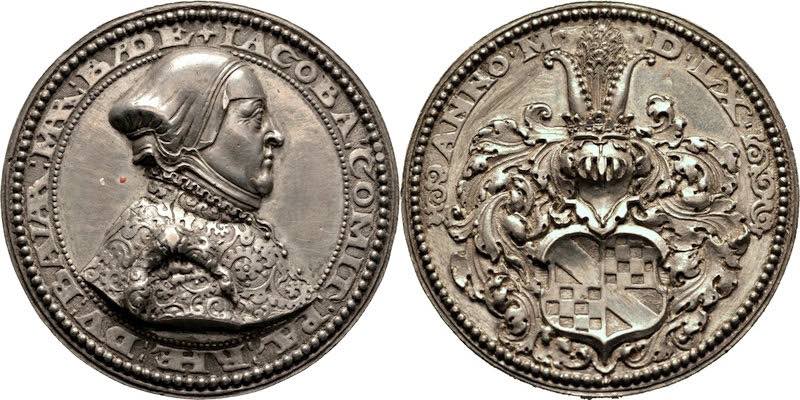
Cast silver medal 1560. Ø 40 mm, 31,70 g. Witt.277. Specimen from the State Coin Cabinet Munich  . .
Obv.: +IACOBA:COMIT:PA:RHE:DV:BAVAR:MAR:BADE - Bust right with a widow's hood. Rev.: ᏪANNO·M - ·D·LX·Ꮺ - paternal coat of arms Baden-Spohnheim with helmet and decoration. Maria Jakobäa (1507-1580) had been a widow for 10 years in 1560.
William's and Jakobaea's son Theodor 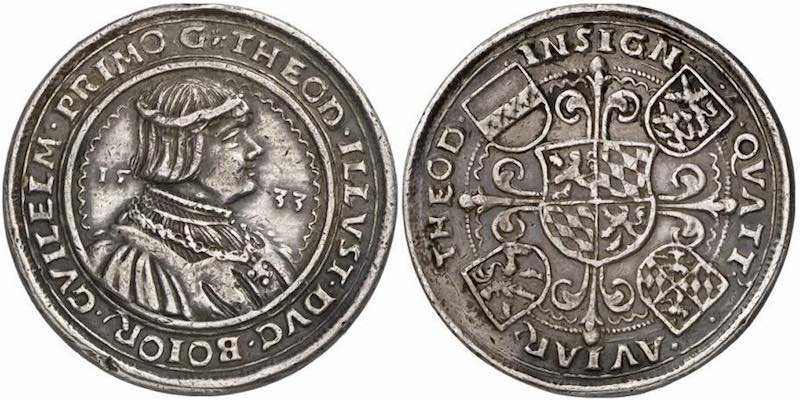
Thick Schautaler 1533, model by Matthes Gebel. Ø 35 mm, 26,14 g. Hauser 13; Witt.555. Obv.: *THEOD·ILLVST·DVC·BOIOR,·GVILELM·PRIMO G "... William's Primogen (first born with succession claim)" Youthful bust to the right with necklace and bandage on the head, on the sides the date I5 - 33. Rev.: ·INSIGN· - ·QVATT'· - ·AVIAR' - ·THEOD· - Quartered coat of arms on a flower-cross, in the angels the coats of arms of Austria, Braunschweig, Katzenelnbogen and Palatinate Bavaria. Theodor (1526-1534) was the eldest son. He would have become the next Bavarian Duke,
but he died at the age of only eight years. |
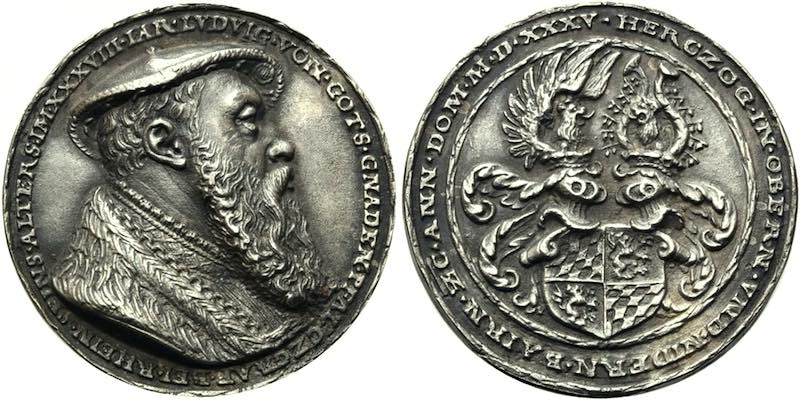
Cast silver medal 1535, model by Matthes Gebel. Ø 42 mm, 30,00 g. Habich 1123; Witt.264. Obv.: LVDVIG·VON·GOTS·GNADEN·PFACZ GRAF·BEI·RHEIN·SEINS·ALTERS·IM·XXXVIII·IAR· "Louis by the grace of God, count Palatine of the Rhine, in his 38th year of age" Bearded bust right, with hat, coat and necklace. Rev.: HERGZOG·IN·OBERN·VND·NIDERN·BAIRN·ZC·ANN·DOM·M·D·XXXV· "duke of upper and lower Bavaria etc, anno domini 1535" quartered coat of arms Bavaria/Palatinate (rhombic/lion), doubly helmeted including crests.
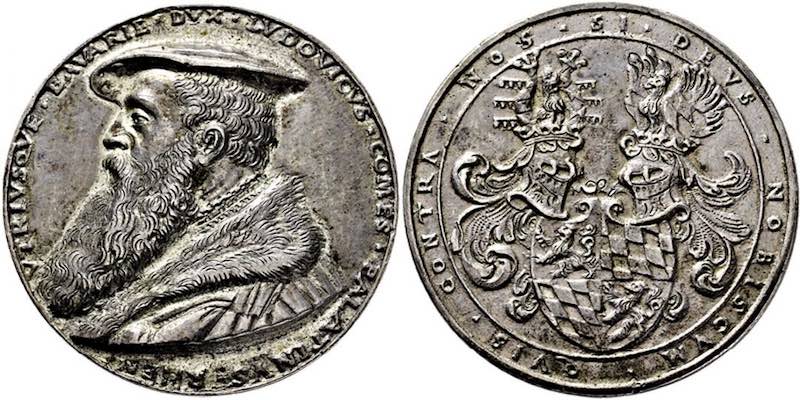
Cast medal n. d. (1535) by Ludwig Neufahrer. Ø 40,3 mm, 23,99 g. Habich 1325; Witt.265. Obv.: LVDOVICVS·COMES·PALATINVS·RHENI· - VTRIVSQVE·BAVARIE·DVX· Bust left with a flat hat and fur coat. Rev.: SI·DEVS·NOBISCVM·QVIS·CONTRA·NOS· "If God is with us, who can be against us?" - Double-helmeted arms Palatinate/Bavaria.
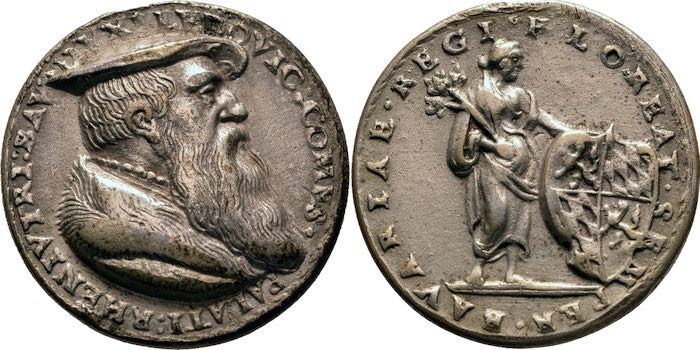
Cast silver medal n. d. by Ludwig Neufahrer. Ø 27 mm, 11,55 g. Witt.266. Specimen from the State Coin Cabinet Munich  . .
Obv.: LVDOVIC:COMES· - PALATI:RHENI VTRI:BAV - DVX Bearded bust right, flat hat and fur coat. Rev.: FLOREAT·SEMPER·BAVARIAE·REGIo· "May flourish Bavaria constantly" Bavaria standing to the right holds the bavarian coat of arms in her left hand, and a flowering branch reaching over her shoulder in her right hand.
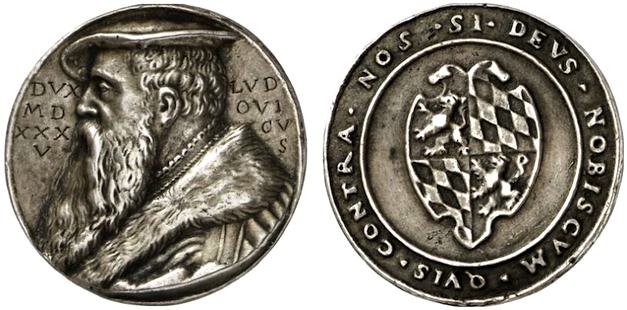
Cast medal (1535), unsigned. Ø 25,4 mm, 6,08 g. Habich 1324; Witt.267. Effigy to the left with fur coat and hat. // Arms Palatinate/Bavaria. SI DEVS NOBISCVM QVIS CONTRA NOS "If God is with us, who can be against us?"
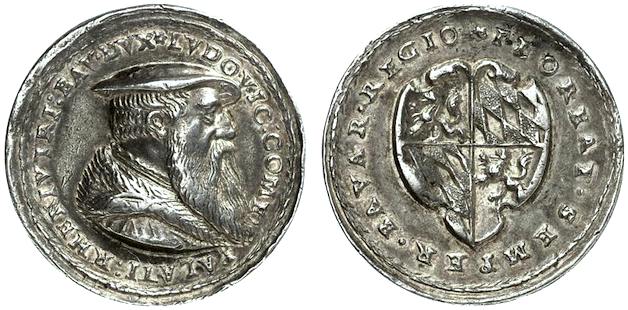
Silver medal n. d. around 1535, by "Meister der Gruppe des Herzogs Ludwig". Ø 24,3 mm, 9,86 g. Habich 1327; Witt.268. Obv.: ¤LVDOVICus:COMEs - PALATInus:RHENI VTRIsque:BAVvariae·DVX Bearded effigy to the right with folded coat and flat hat. Rev.: ¤FLOREAT·SEMPER·BAVARiae·REGIO - Coat of arms Palatinate/Bavaria (lion/rhombuses).
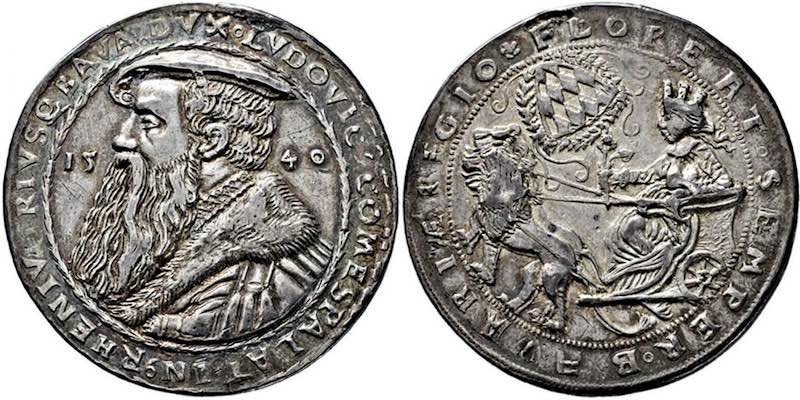
Cast medal 1540, unsigned. Ø 36,9 mm, 22,69 g. Habich 1411; Witt.269. Obv.: LVDOVIC·COMES·PALATIN9·RHENI·VTRIVSQ BAVA·DVX Bust to the left, with beret and fur hood between date 15 - 40. Rev.: FLOREAT*SEMPER*BAVARIÆ*REGIO* "May flourish Bavaria constantly" Personification of Bavaria with a mural crown in a chariot drawn by two lions to the left. |
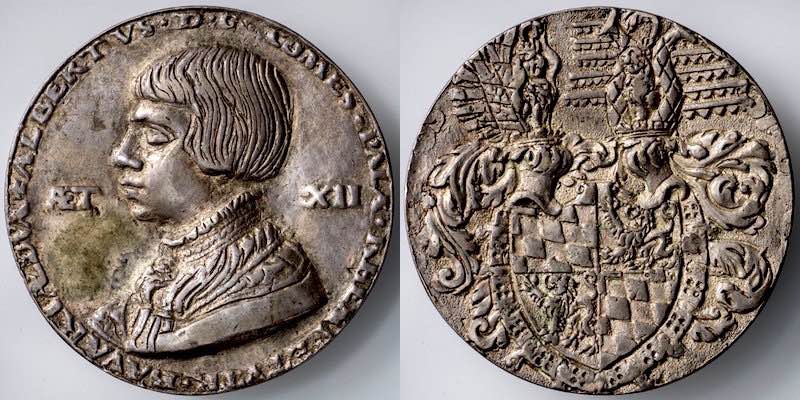
Cast silver medal (1540) commissioned by his father. Ø 37 mm, 15,69 g. Witt.381. Specimen from State Coin Cabinet Munich  . .
Obv.: ALBERTVS Dei Gratia COMES PALAtinus RHENI ET VTRisque BAVARIAE DVX Juvenile bust left, between ÆTatis - XII. Rev.: SI DEVS NOBISCVM QVIS CONTRA NOS Double-helmeted coat of arms Bavaria/Palatinate (diamonds/lion) with Order of the Golden Fleece.
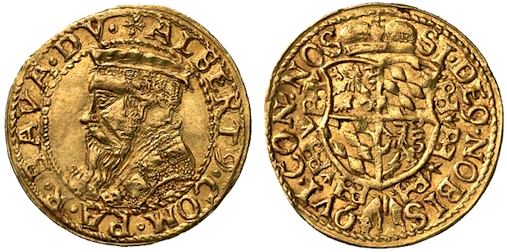
Dukat n. d., Munich. Ø 21 mm, 3,43 g. Hahn 50; Witt.418a/c; Friedb.183. Obv.: ✥ALBERTus9·COMes·PAlatinus·Rheni·BAVAriae·DVx· [9 = us] Bearded bust to the left with a cap and the collar of the Order of the Golden Fleece. Rev.: SI·DEus9·NOBIScum - QVIs·CONtra'·NOS "If God is with us, who can be against us?" Quartered shield Palatinate/Bavaria surrounded by the collar of the Order of the Golden Fleece. Duke Albrecht V had been awarded the Order of the Golden Fleece in 1546.
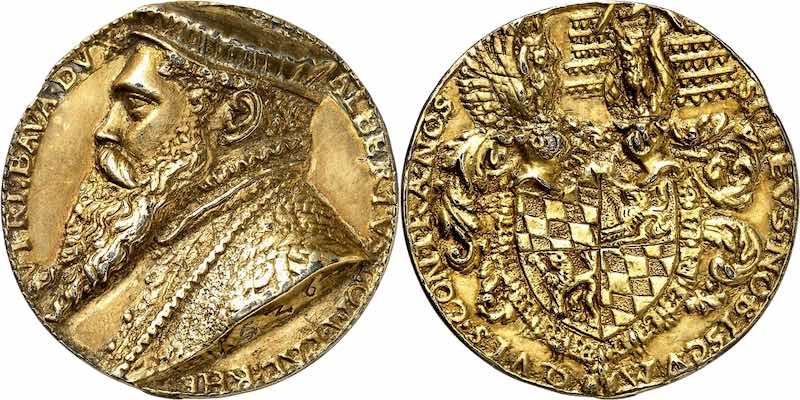
Gilded silver medal n. d. (after 1554) following Hans Aesslinger. Ø 40 mm, 20,70 g. Habich 3171; Witt.384 (this piece). Obv.: ALBERTVS COM·PAL·RHE - VTRI·BAVA·DVX Bearded bust left, engraved in section in 1526. Rev.: SI·DEVS·NOBISCVM - QVIS·CONTRA·NOS Double-helmeted shield, around the collar and order of the Golden Fleece.
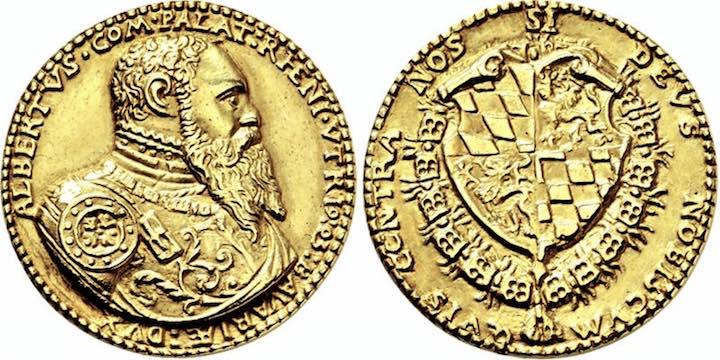
Gold medal n. d., after 1554, unsigned, model by Hans Ässlinger. Ø 28,5 mm, 14,90 g. Habich 3174; Witt.387. Obv.: ALBERTVS·COM·PALAT:RHENI·VTRI9:03:BAVARIÆ:DVX Bareheaded bust to the right with decorated armor and collar of the Golden Fleece. Rev.: SI DEVS NOBISCVM - QVIS CONTRA NOS Quartered shield Bavaria/Palatinate, surrounded by the collar and order of the Golden Fleece.
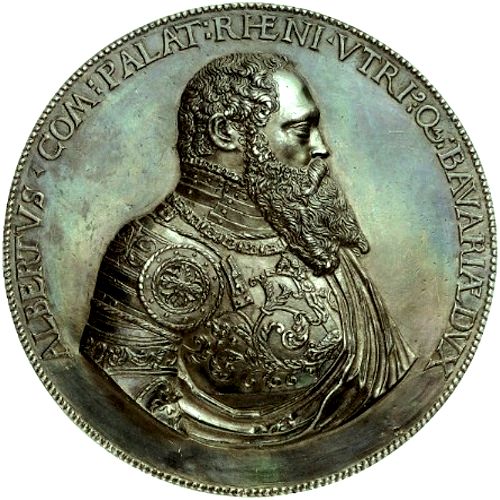
Touch the picture with the cursor in order to see the revers. Cast silver medaillon 1558. by Hans Ässlinger, original cast. Ø 124 mm, 402,8 g. Habich 3176; Witt.388. Obv.: ✥ALBERTVS·COMes:PALATinus:RHENI·VTRIus':Que:BAVARIÆ'DVX Bearded bust to the right, in decorated armor with Golden Fleece and sash. Rev.: PARCERE SVBIECTIS ET DEBELLARE SVPERBOS 1558 "Protect subjugated and defeat the arrogant" (Virgil, Aeneid) Lion tears bull, on the right another lion protects a lamb. Two castles connected by a bridge over a raging river are in the background. On top an angel is hovering with two wreaths.
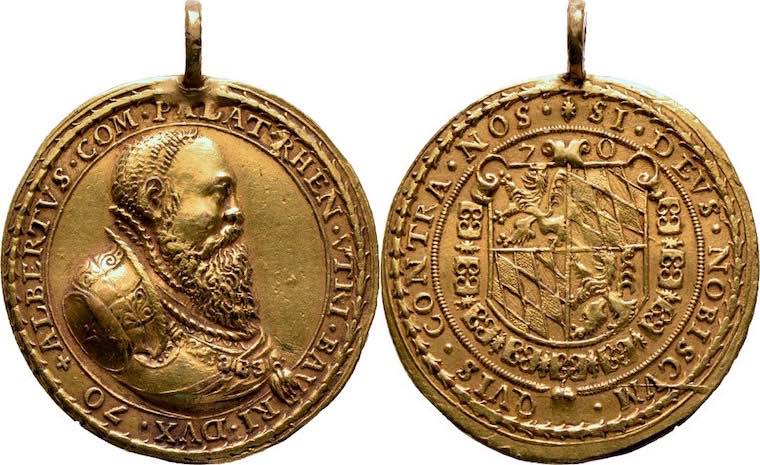
Gilden cast bronze medal 1570 with handle. Ø 37,4 mm, 19,22 g. Witt.400. Specimen from State Coin Cabinet Munich  . .
Obv.: +ALBERTVS·COM·PALAT·RHEN·VTRI·BAV - RI·DVX·70 Rev.: ✴SI·DEVS·NOBISCVM· - QVIS·CONTRA·NOS·
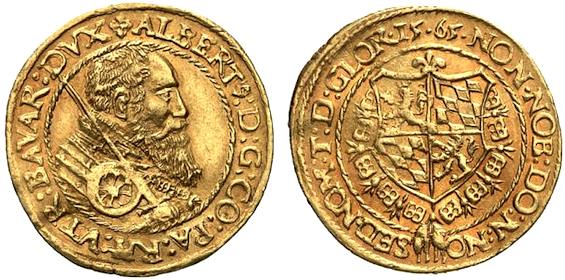
2 Ducats 1565, Munich. Ø 25 mm, 7,03 g. Hahn 52; Witt.414; Friedb.182. Obv.: ✥ALBERTus9:Dei:Gratia:COmes:PAlatinus:RHeni:VTRiusque:BAVARiae:DVX Bust to the right, in armor and shouldering the sword with his right hand. Rev.: NON·NOBbis:DOmibe:Non:NObis - SED·NOMine:Tuo:Da:GLORiam·15·65· "Not us, O Lord, not us, but your name give honor!" Quartered shield Palatine/Bavaria, surrounded by the collar of the Order of the Golden Fleece.
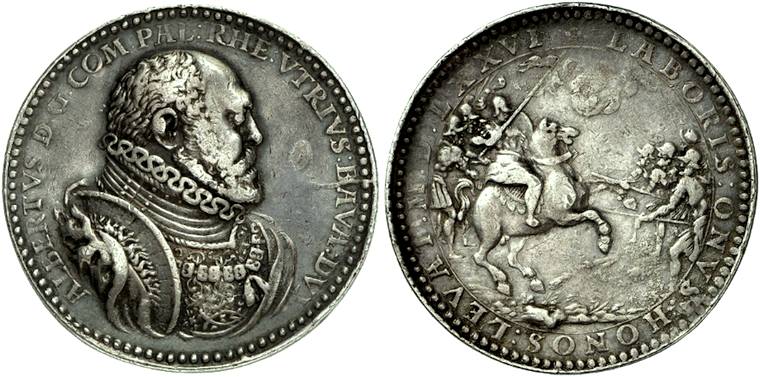
Schautaler 1576. workshop H. Gerhard. Ø 43 mm, 29,10 g. Habich II,2 3188; Witt.408. Obv.: ✥ALBERTVS D.G:COM PAL:RHE.VTRIVS:BAVA:DVX Bust in armor to the right, with coat and collar of the Order of the Golden Fleece. Rev.: LABORIS:ONVS:HONOS:LEVAT:M:D:LXXVI Two troops moving against each other, left army leader with flag on a horse leaping to the right.
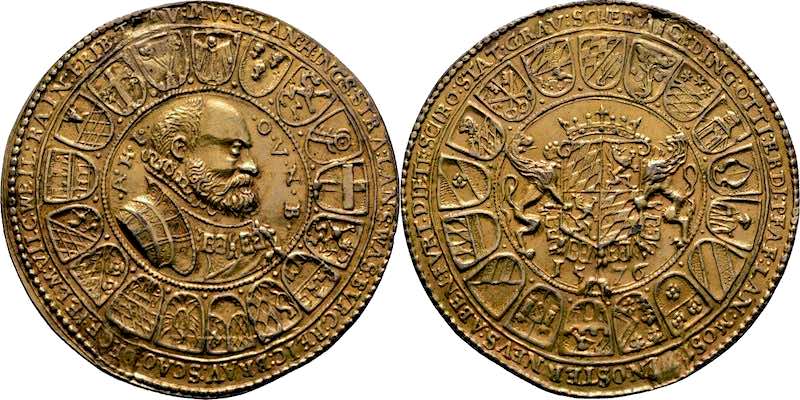
Gilden embossed silver medal 1576. Ø 42 mm, 15,75 g. Witt.411. Specimen from State Coin Cabinet Munich  . .
Obv.: Bust right in armor, golden fleece, around ·Albrecht·Herzog·In· - ·Ober·Vnd·Nieder·Bayern·. Around 17 City arms with associated names: MVNChen LANdsHut INGolstadt STRAubing LANdSberg WASserburg BVRGhausen REIChenhall BRAVnau SChongAO DEGgEndorf KELheiM VILCshofen WEILheim RAIN FRIedBerg TRAVnstein. Rev.: crowned square coat of arms held by two lions, Order of the Golden Fleece and date 1576. Around 17 more coats of arms with associated city names: SHE(ä)Rding AIChach DINGolfing OTTIng ERDIing PFAFfenhofen LANdau MOSPburg WEN(m)ding OSTERhofen NEVStadt ABENsberg FV(ü)RTh DIETFurt SCHRObenhausen STATanhof GRAV(f)enau. Duke Albert V together with his wife Anna
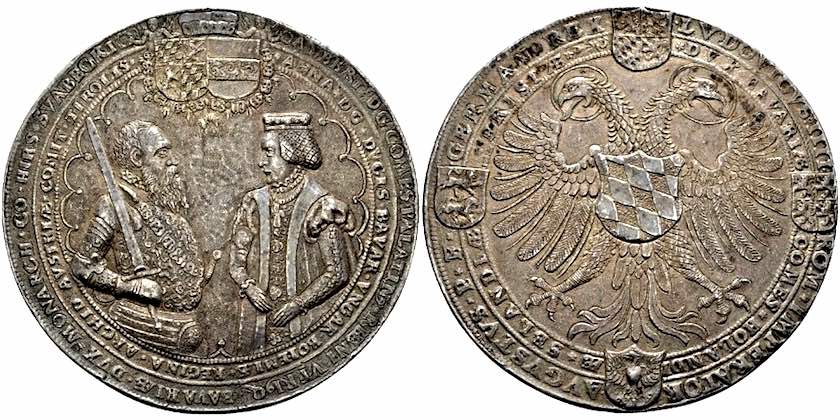
Silber medal n. d., later cast. Ø 71,2 mm, 96,00 g. Witt.393. Obv.: ALBERT9 D:G COMES PALATIN9·RHENI·VTRI9 Q·BAVARIÆ·DVX·MONARCH CO HIRS SVABECKI inside: ANNA·DG·DVCIS·BAVAR·VNGAR·BOHEMIÆ·REGINA·ARCHID·AUSTRIÆ·COMIT·TIROLIS· Half-length of Albert V in armor with shouldered sword and his wife Anna, opposite each other. Above the escutcheons of Bavaria and Habsburg side by side, surrounded by the collar of the Order of the Golden Fleece. On top two angels with wreaths hold the princely hat. Rev.: LVDOVICVS·IIII - ROM·IMPERATOR - AVGVSTVS·P·F· - GERMAN·REX inside: ·DVX·BAVARIÆ - COMES·HOLANDI - Æ·SELANDIÆ - FRISIÆ· Imperial double eagle with bavarian shield on the chest. Four small shields interrupt the legend.
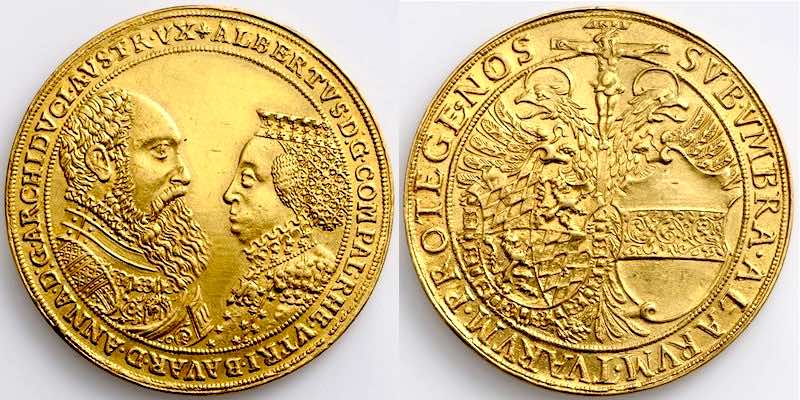
Embossed gold medal n. d. issued at the wedding in 1546. Ø 40,4 mm, 37,54 g. Witt.394. Specimen from State Coin Cabinet Munich  . .
Obv.: ALBERTVS D G COM PAL RHE VTRI BAVAR D ANNA D G ARCHIDVCI AVST VX Zugewandte Büsten. Rev.: SVB VMBRA ALARVM TVARVM PROTEGE NOS "Take us under the shadow of your wings" Arms of Bavaria/Palatine and Austria, placed on nimbite double eagle with crucifix.
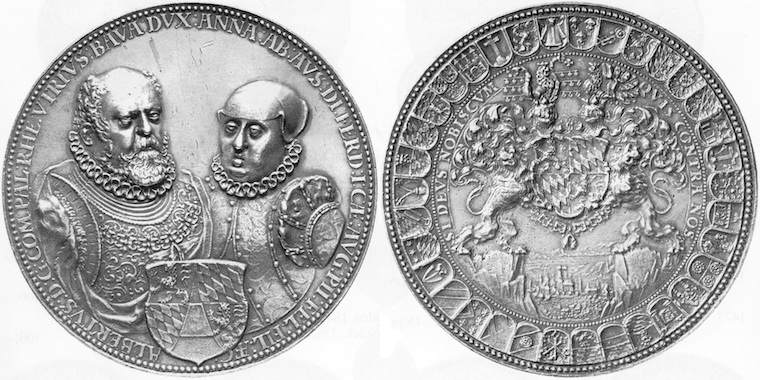
Embosed silber medal n. d., c. 1576. Ø 81 mm, 113,0 g. Habich 3185; Witt.405. Obv.: ALBERTVS:D:G:COM:PAL:RHE:VTRIVS:BAVA:DVX:ANNA:AB:AVS: DI:FERD:I:CÆ:AVG:PII:FEL:FIL:ÆC· Bust of the couple almost from the front, the duke bareheaded in armor with field bandage and collar of the Order of the Golden Fleece, the Duchess with hood. In front of the couple the quartered Bavarian shield split below by the Austrian shield. Rev.: SI DEVS NOBISCVM - QVIS CONTRA NOS "If God is with us, who can be against us?" Two lions standing on rocks hold the twice-helmeted, quartered Bavarian coat of arms. Behind a view of Munich with the two towered cathedral Frauenkirche. Around a circle of 34 coat of arms of Bavarian cities: 1. Munich, 2. Landshut, 3. Straubing, 4. Wasserburg, 5. Reichenhall, 6. Schongau, 7. Kelheim, 8. Weilheim, 9. Friedberg, 10. Aichach, 11. Ötting, 12. Pfaffenhofen, 13. Moosburg, 14. Osterhofen, 15. Neustadt a. D., 16. Schrobenhausen, 17. Furth, 18. Grafenau, 19. Stadtamhof, 20. Dietfurt, 21. Abensberg, 22. Wemding, 23. Landau, 24. Erding, 25. Dingolfing, 26. Schärding, 27. Traunstein, 28. Rain, 29. Vilshofen, 30. Deggendorf, 31. Braunau, 32. Burghausen, 33. Landsberg, 34. Ingolstadt.
|
|
Ref.:
• Hahn, W.R.O. : Typenkatalog der Münzen der bayerischen Herzöge und Kurfürsten 1506-1805. Braunschweig 1971. • Habich, G. : Die deutschen Schaumünzen des XVI. Jahrhunderts - Bd.I, 1st part: Munich 1929. XXXVI & 130 p. (No.1-?) & plates 1-109 - Bd.I, 2: Munich 1931. p. XLI-LXXVI & 131-262 (No.?956-1843) & plates 110-196 - Bd.II,1: Munich 1932. p. LXXXI-CXXIV & 263-460 (No.1844-3182) & plates 197-302[CXCVII-CCCII] - Bd.II,2: Munich 1934. p. CXXIX-CXXII & 461-557 & plates CCCIII-CCCXXXIV + [appendix] 48 S. • Beierlein, J.P. [Witt.] : Die Medaillen und Münzen des Gesamthauses Wittelsbach. Munich 1897/1901. |
 start page
start page